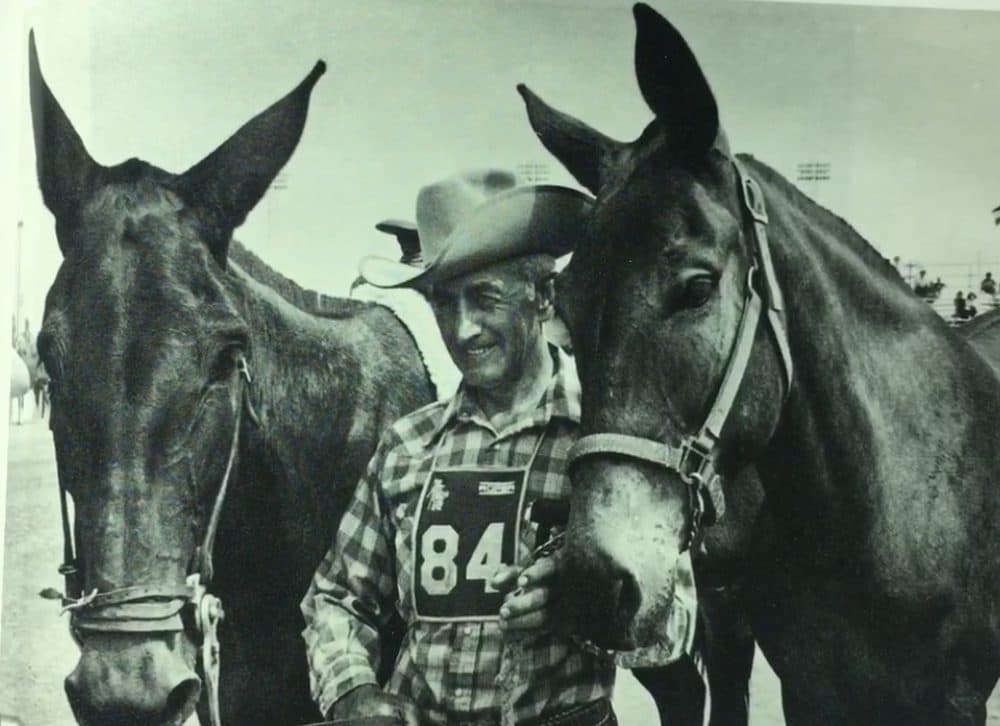Advertisement
How A Steeplejack, A Teenager And A Mule Won The Great American Horse Race
Resume
This story originally aired on Sept. 9, 2016. This week it appears again as part of our "Summer Vacation" show.
The year was 1976.
"People were looking for a party," recalls Curt Lewis, who in 1976 had just finished his journalism degree at Wichita State. "Vietnam was just over in '75. Watergate was over. Nixon was gone," he says. "Everyone was looking for a good time."
And there was an excuse to celebrate. The U.S. was turning 200 — and the birthday party seemed to last all year.
In honor of the bicentennial, trains and airplanes were painted red, white and blue. A fleet of tall ships sailed down the Hudson River.
And there was a horse race unlike any other.
The Great American Horse Race
It was called the Great American Horse Race, and it would span nearly 100 days and 3,500 miles, starting in New York, heading to Missouri, and then following the Pony Express route to California.
Lewis was hired by the race organizers to document all the greatness and Americaness of the Great American Horse Race. And also the competition.
The rider who covered the distance fastest would get $25,000 – worth about $100,000 in today’s dollars.
About 100 riders signed up. Cowboys took a break from rodeos. World War II veterans, finished with their missions on submarines and B-17 bombers, also entered. So did a sheriff — and even an Austrian count.
"Count Johannas Hoyos — and he was a good guy," Lewis says.
And then there was Virl Norton. He was one of the oldest riders. He didn't have as big a bank account as most of the others. He didn't have any fancy horse equipment. Or a big crew to help him set up camp or cook or do laundry.
But he had a plan.
'If You're Not Riding An Arabian...'
While some riders entered Icelandic ponies, quarter horses, and Appaloosas, the consensus was that the horse to ride if you wanted to win was an Arabian.
"The sport of endurance horse riding is won by Arabian horses," Lewis says. "The motto: if you're not riding an Arabian, you're following an Arabian."
"The sport of endurance horse riding is won by Arabian horses," Lewis says. "The motto: if you're not riding an Arabian, you're following an Arabian."
But Virl Norton was going to challenge that motto.
It was the Great American Horse Race, but Virl Norton entered...a mule.

"He always had a hankering for mules, I think maybe from his childhood," says Virl's son, Pierce.
Most of the riders had a crew of two or three to help along the race. Virl only had Pierce. And Pierce was only 16.
"I had just gotten my driver's license in March," Pierce says. "Guess I had to learn how to drive pretty fast."
Even with a mule and a crew of one teenager, Virl Norton was confident that he was going to win.
"He was quite a social, charismatic guy, and we'd go into a restaurant, and he'd start talking about it," Pierce says. "And he wouldn't kind of hold back his confidence. And I would kinda be a little sheepish back there, thinking, ‘Well, we need to see what's gonna happen here.’"
So why did Virl Norton have such confidence in his mule and his 16-year-old son?
The Origin Story
Virl Norton was born in Wyoming in 1916. As a teenager, he caught and trained wild horses. He and his family also worked mules on their farm.
"So, he had an understanding of what the strengths and weaknesses of mules were," Pierce says.
Virl learned that mules are slow — generally not a good quality for a race. But he also learned that mules have stamina and durability — good qualities for the 3,500-mile Great American Horse Race.
Virl got married and settled in San Jose, California. He worked as a steeplejack -- he went around the country painting tall things like towers and smokestacks. And he had a family.
"There was five of us children and my mother," Pierce says. "And then my dad would be out painting. And he'd be out in Sacramento or North Dakota or some place, and he'd come home every couple weeks. When I was about 8 years old, my mom got breast cancer and got pretty ill. And all of us kids, since my father wasn't there all the time, we got shipped off to some relatives in Idaho and Wyoming. We were all with different relatives. "
Pierce ended up in Idaho.
"I went up to my uncle Delos's, who had a cattle ranch and farm," Pierce says. "And he had six kids there himself in a two-bedroom house. You're getting up in the morning, feeding cows and things like that. It's a completely different life. When I first went up there, I think kind of the pretense was, 'This is a temporary thing. We're going to go up until my mother gets better.' Now, that's what I understood as an 8-year-old kid. So I was at my Uncle Delos's house and he got a phone call. This was in the May of '69, when my mother died — and that was the phone call. And I think I became an adult right there. Everything became clear. I'm on my own at this point."
"I think I became an adult right there. Everything became clear. I'm on my own at this point."
Pierce and his siblings stayed on with relatives. Meantime, Virl sold the family's home in San Jose to pay off hospital bills. He moved into a house trailer on the family ranch outside of town.
But unlike his siblings, Pierce didn't adjust well to his new setting.
"I never quite fit in and became one of the family," he says.
So when Pierce was 12, his father came to get him. Pierce moved onto the ranch with his dad.
"He had another house trailer right next door," Pierce says. "So I lived in my own house trailer from the time I got down there at 12 years old. He would seriously be gone for a month or more at a time, and I would just take care of the ranch and myself and get to school and cook my meals and do my laundry and whatever else had to be done. It didn't seem strange to me. It probably seemed strange to other people."
Which is to say that by the time Virl Norton saw the ad for the Great American Horse Race in the magazine Western Horseman, 16-year-old Pierce Norton was well prepared to be his dad's crew.
So Virl and Pierce set out from California for the starting line in New York in a 1971 Dodge pickup with loose steering, hauling a camper and a low-end horse trailer that didn't have any horses in it. What it did carry was Lord Fauntleroy, nicknamed Leroy, and a backup mule named Lady Eloise.
The Race Begins
On May 31, 1976, the Great American Horse Race began.
The race was structured like the Tour de France. There was a set course for each day — usually about 35 miles — and the riders were clocked at the start and finish.
At first, Virl's strategy didn't pay off.
"There was people going full blast the first day," Pierce says. "Probably rode twice as fast as my dad did. Sooner or later you start to wonder, you know, 'I wonder if this is a good strategy?' I'm thinking, 'If these guys keep it up, there's no way we're going to be able to make up this time.'"
But here's another thing you need to know about the Great American Horse Race — and maybe you've been wondering this. Veterinarians accompanied the group, and there were mandatory checks throughout the day. If a horse — or mule — showed any signs of breaking down, even if it just wasn't walking right, the horse — or mule — would have to ride in the trailer until it was healthy again. And that meant penalty time for the riders.
So, as the days went on, more and more horses started breaking down. And more and more riders started getting penalty time.
And that wasn't the only thing slowing some teams…
"There was plenty of drinking on this thing," Lewis says. "People in the middle of the night screaming and hollering and fighting and 'Where's my girlfriend?' and that sort of thing."
And while other competitors were getting into trouble, Lewis says Pierce was "absolutely, positively focused."
"I mean, he was busy all the time," Lewis says. "He was doing things. It was a full time job doing all the things he had to do. Laundry, shopping, groceries, cook and all that sort of thing."
And with a focused crew and a healthy ride, sure enough...
"They had a begrudging respect for the mules sooner or later," Pierce says.
Because about a quarter of the way into the race, in Kankakee, Illinois, Virl Norton and Leroy went out ahead of all the Arabians.
"I'm 56 years old now, and, in the 40 years since that race happened, there's not a bigger event in my life."
"He’d always said that he hadn’t planned on taking the lead that early. Everyone ran their horses down a little bit sooner than he thought, I guess," Pierce says. "You know, soon as we got into the lead, there was a long way to go. But we were going in the right direction. The lead was getting longer."
And so, days before the finish, it became clear that a mule was going to win the Great American Horse Race.
And on the last day…
"There was a whole bank of press photographers and just these cameras flashing and going off like crazy. And some of the other competitors put my dad up on his shoulders and ran him around the fairground a little bit," Pierce says. "I don't know if we ever really had a kind of moment where we did a high-five. He wasn't that kind of guy. He could just look over and nod at me and I would know that he was satisfied with the job that I did."
Life After The Great American Horse Race
Winning the race got Virl Norton into newspapers and on TV. It earned him respect among his horse-loving friends for the rest of his life. For Pierce, there was no fame. When the race was over, he went back to high school. He's a scientist now and he says he hasn't ridden a horse — or a mule — in 20 years.
But the Great American Horse Race remains special.
"I'm 56 years old now," Pierce says, "and, in the 40 years since that race happened, there's not a bigger event in my life."
Virl Norton died in 1995. His son remembers him fondly.
"I come to appreciate some stuff kind of later on," he says. "You know my dad raised me kind of on his own, and his best attribute was that he could get more out of a person than they thought they could give. He would give you an opportunity to prove to yourself that you were good."
And in 1976, Virl and Pierce Norton and their mule, Leroy, proved to America that they weren't just good. They were great.
To read more about the race, check out Curt Lewis’s book with Dennis Underwood, “The Great American Horse Race of 1976: A Photographic Documentary,” or Atlas Obscura’s story, “The 1976 Great American Horse Race Was Won By A Mule Named Lord Fauntleroy.”
This segment aired on July 29, 2017.
